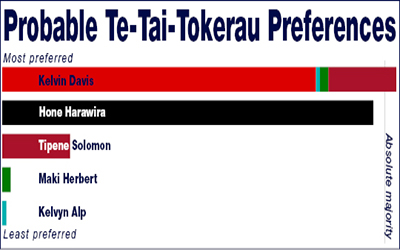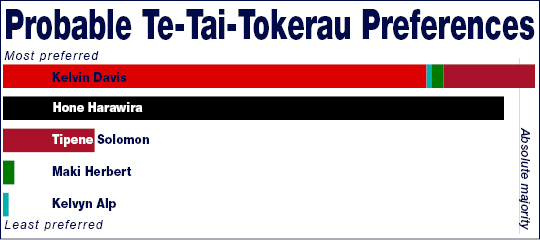First-past-the-post ‘win’ argument for preferential


A Few Preferences Short of a Mandate: Had Saturday’s by-election been held with a halfway intelligent voting system, Hone Harawira would probably have lost his seat. Either way, talk of a mandate is much inflated. chart Mahurangi Magazine
It is easily overlooked.
Aotearoa may enjoy exemplary proportional representation, but electorate representatives are still elected by the multiply flawed first-past-the-post system.
Voters in last Saturday’s by-election were allowed to express only their first preference. And Hone Harawira was the first preference of 48.5% of the voters—not including special and overseas voters.
But had voters’ second and subsequent preferences been taken into account, as they should be in a robust electoral system, Mr Harawira would likely have lost to Kelvin Davis, who might conceivably have been preferred by 51.5% of the voters.
Only so much can be extrapolated from Saturday’s crude, first-past-the-post voting. Voters may have expressed their first preference differently, had they been allowed to fully express their preferences. Regardless, the mandate claimed by Mr Harawira is not supported by the numbers. As Māori Party candidate for Te Tai Tokerau electorate at the last general election, Hone Harawira polled 12 019 votes—212% more than he did on Saturday. Even allowing for the inevitably lower by-election voter turnout, it’s hardly the ringing endorsement for his breakaway Mana Party that Harawira hoped for.
The mixed member proportional system was adopted primarily to enfranchise minor parties. It is deeply ironical that the only minor party (as opposed to one-man bands) to successfully engage in government since is the Māori Party, which owes its electoral success not to the proportional system, but to the separate Māori roll—the Māori Party share of the party vote was a paltry 2.39%.
But the other factor in the Māori Party’s success in government was National Prime Minister John Key’s inspired move to lead a true coalition government. While the Green Party spurned the offer, the Māori Party had the courage to accept it at face value, and has proved to be an astute and effective coalition member. This seriously undermines the anti-MMP brigade’s disingenuous contention that minor parties have too much clout. They can have, but only where the coalition leaders act out of desperation rather principle. The expedient exclusion of the Green Party by Helen Clarke in 2005 reflected that leader’s long-held distain for proportional representation. And by buying New Zealand First’s seven seats by yielding to the extortion of that party’s leader to be made Minister of Foreign Affairs, Ms Clarke further fueled disgust for proportional representation and politics in general, and helped pave the way for the trashing of her Labour Party in 2008.
As Aotearoa approaches its referendum in November, much money is been thrown at a desperate campaign aiming to convince New Zealanders to opt for anything but mixed member proportional—MMP. That ex-mayor Kerry Prendergast has joined the anti brigade is unsurprising; Prendergast would have been re-elected last year, had first-past-the-post been used by Wellington City Council. Fortunately, 60% are happy with the system, or happy to see it retained with ‘some changes’.
It is unlikely that the changes envisaged by Justice Minister Simon Power include the elegantly simple solution of allowing voters to express a second, third or more preference, when they vote. This is primarily because, prior to the advent of the computer, the manual distribution of preferences was famously time-consuming.
The democratic world can thank a New Zealander, Stephen Todd, for the first successful computerisation of Meek’s method of distributing preferences. And it would be entirely consistent with New Zealanders’ self-image as innovators, if Aotearoa was to be the first country to seamlessly blend the best proportional voting system (mixed member) with the best preferential voting system.
Only one change to the ballot paper would be needed. Rather than ‘Vote for only one candidate’, the instruction would read:
Rank one or more candidates in order of preference … ‘1’, ‘2’, ‘3’ etc.
Same-same for the party vote—except that here, the only preferences to be distributed would be those from parties that failed to meet the arbitrary five percent threshold and failed to capitalise on the ill-conceived coattail provision. In 2008 these parties numbered 12, headed up by New Zealand First. Between them they wasted 153 461 votes, notwithstanding that 13 016 of those votes—those gained by the Bill and Ben Party, runner up to New Zealand First—were wasted wilfully.
Saturday’s result is yet another failure of first-past-the-post, and further reason for New Zealanders to vote in November to retain and improve their hard-won proportional system.
1 2 3, tune-up MMP!
